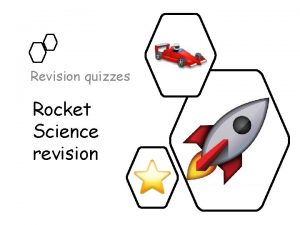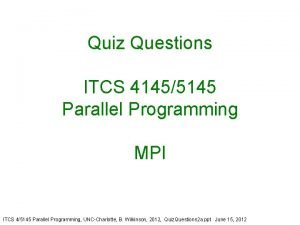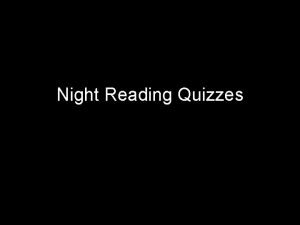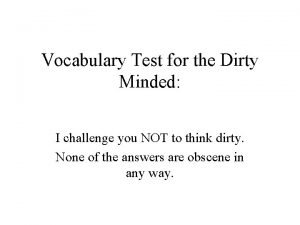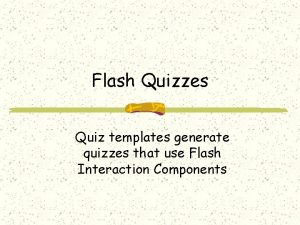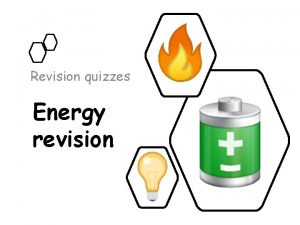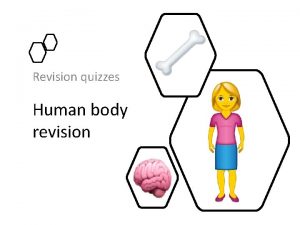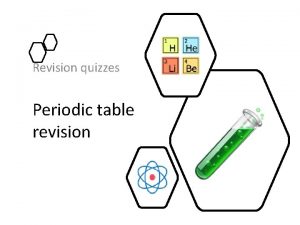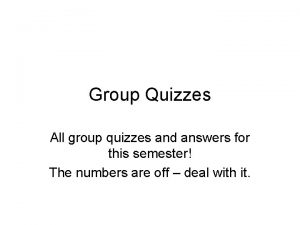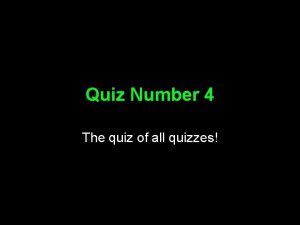Revision quizzes Rocket Science revision Quiz 1 1








- Slides: 8

Revision quizzes Rocket Science revision

Quiz 1 1. Forces are either push or pull. Create a table showing which of the following are push or pull 2. What are three things that can happen to an object when a force is applied? 3. Copy and complete the following sentence Forces that act on a object by touching them are know as________. An example of this force is ______. There are some forces that do not need to touch an object to act on them, these are known as ____. An example of this type of force is _______.

1. Quiz 2 What piece of equipment is used to measure forces? 2. What are the units used to measure forces? 3. Who are they named after and why? 4. Below an bar graph showing the force required to lift different objects a) Which object requires the most force to lift? b) Which object required half the force of the masses to lift? c) What force was required to lift the shoe?

Quiz 3 Use the table and equations to calculate weight and mass Planet Mercury Venus Earth Mars Jupiter Saturn Uranus Earth's moon 1. 2. 3. 4. 5. 6. 7. 8. Gravity (N/kg) 4 9 10 4 25 10 11 1. 6 Weight = Mass x Gravity Mass = Weight ÷ Gravity Calculate the weight of an 85 kg (mass) astronaut on Mercury Calculate the weight of a 100 kg (mass) space rover on the Moon Calculate the weight of 40 kg (mass) crate on Jupiter Calculate the weight of a 10000 kg (mass) shuttle on Mars Calculate the mass of a 600 N (weight) boy on Earth Calculate the mass of 720 N (weight) alien on Venus Calculate the mass of 2250 N (weight) astronaut on Jupiter Calculate the mass of 80 N (weight) crate on Saturn

Quiz 4 For each example below decide if the forces are balanced or unbalances and what the net force is in each example. 1. 2. 50 N 30 N 4. 3. 445 N 3872 N 650 N 15 N 145 N 3872 N 5. 6. 7 N 7. 8. 58 N 100 N 295 N 97 N 28 N 446 N

1. Quiz 5 Explain what friction is? 2. Give an example of surface that will have a lot of friction 3. Give an example of surface that will have little friction 4. The table below shows the results of an experiment to measure friction of different surfaces. The experiment was carried out three time for each experiment. Calculate the average force for pulling over each surface.

Quiz 6 1. Copy and complete the following passage ______ is the name given to an object or animal that’s shape reduces friction. Objects that are _____ and _____ usually have less friction. Objects that are _____ and _____ usually have more friction. 2. Give three ways each of the following things have been streamlined to reduce friction.

Quiz 8 Use the triangle or calculations at the side to answer the following speed distance time questions. 1. Calculate the speed of car that has travelled 50 miles in 2 hours 2. Calculate the speed of cheetah that ran 150 m in 10 seconds 3. Calculate the distance travelled by a cyclist travelling at 40 km/h for 3 hours 4. Calculate the distance travelled by an aeroplane travelling at 500 mph for 30 minutes 5. Calculate the time taken for a runner to run 25 miles when running at a speed of 10 mph 6. Calculate the time taken for a truck to travel 500 miles if driving at 60 mph
